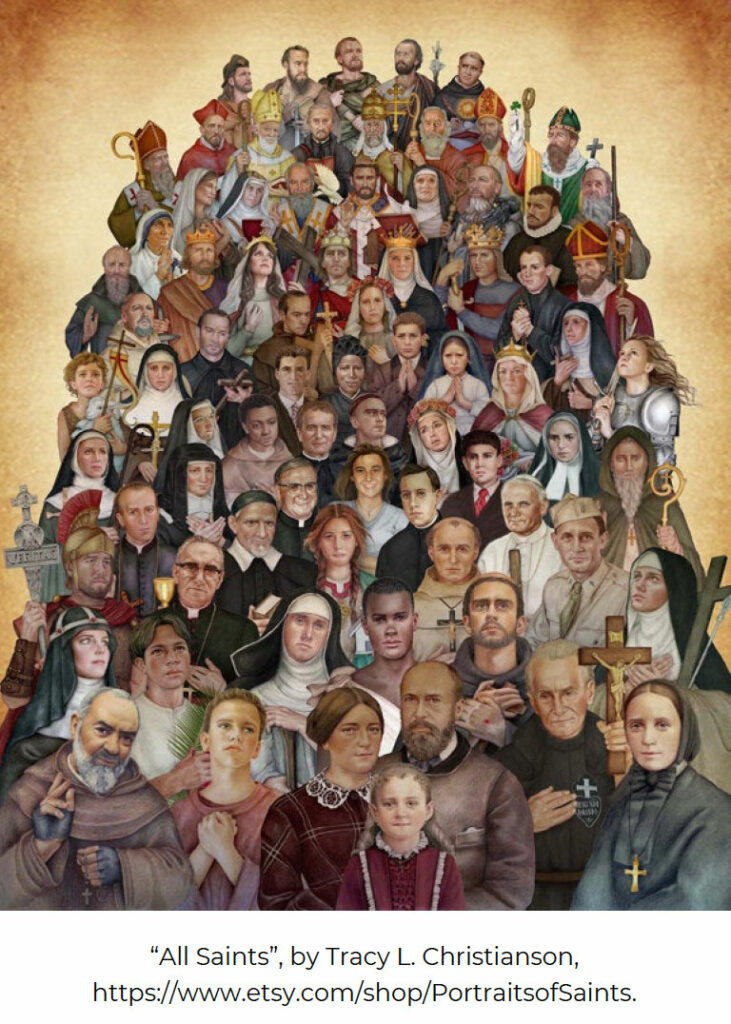Feast Day: November 1st

I know … the feast of All Saints is next Sunday, so why write on them this soon? Well, for most solemn feast days (solemnities), we begin to celebrate them the evening before, and since this particular evening has the title, “All Hallows Evening”, shortened in our day to “Halloween”, it seems something we should talk about before its upon us!
Our story begins in Rome, Italy, with Pope Boniface IV, who on May 13th, 609 consecrated the greatest of Rome’s pagan temples, the Pantheon, previously dedicated to a whole pantheon of gods (Jupiter, Venus, and Mars), instead as a Christian Church, dedicated to “St. Mary and All the Martyrs. And so began the Christian celebration of all the saints on May 13th. Gregory III, moved the celebration to November 1st, because in 741AD he built a chapel St. Peter’s Basilica to house the relics of countless saints, a feast day that was expanded to the whole Church by Gregory IV another century later.
Some say that Pope Boniface chose the original date of May 13th because a Roman, pagan, festival of ghosts (Lemuria) happened on that day. Problem: the Roman festival also happened on May 9th and May 11th, so it does not match perfectly, and there were deep Christian precedence for a late-spring feast for all the saints already. By the 3rd or 4th century, you have St. Ephrem celebrating All Saints on May 13th, Christians in Syria did so on the Friday after Easter, those in Antioch on the Sunday after Pentecost, which was the day chosen in Germany as well. In other words, pretty much as soon as Christians were not persecuted anymore, and now that they had far too many martyrs to give each their own feast day, they started celebrating all the Saints on one big feast, about the time that it was warm enough outside to party.
Ok, so what about November 1st? Some claim that Gregory III was just co-opting the Gaelic feast of Samheim to a more wholesome purpose. They point to the bonfires, costumes, various foods, and recollection of dead ancestors that all eventually became part of that pagan feast. But, it is a bit of a stretch since the Celts had similar feasts every quarter of the year, and furthermore, Samheim actually falls on October 31st. The simpler explanation is that both pagans and Christians were equally apt to choose times of the year when there was both sufficient food, and still nice weather, to have a feast, and so we have November 1st.
Our story now takes us to France, where in 998 AD, St. Odilo (an important abbot) added a feast on November 2nd to pray for the souls in purgatory: All Souls Day. Five centuries later, as the Black Plague devastates Europe, there in France in particular, first in art and then in real life, they begin to dress up as various characters at different points between birth and death. Humor in the midst of horrors is far better than hopelessness, or hatred.
Meanwhile, in Ireland, instead of costumes, we find households making various baked-goods, ostensibly placed outside for the dead, but soon enough, attracting the surrounding youngsters, who began to go door-to-door begging for treats. It would be many more centuries before hollowed-out pumpkins/guards/squashes would be carved into ghoulish faces and lit from within, but perhaps autumn + baking + the need for light + the recollection of the dead started them in that direction.

Now we go to England, where on November 5th, 1605, a crazy Catholic named Guy Fawkes tried to blow up the (newly Anglican) British Parliament. He was foiled. The Anglicans were mad. And so November 5th became a day when revelers would put on masks, and head to the nearest Catholic’s home demanding beer and cakes … or else.
And then, all those fine folks came to the USA, and the costumes, candies, and trick-or-treating melded into Halloween … and the Holy-Ones for whom all those festivities were intended meanwhile have been forgotten.
Don’t forget them this Saturday evening. Sanctity is more exhilarating than sugar, and the sacraments are more sustaining than sweets.
– Fr. Dominic Rankin has been a baptized Christian for 27 years, a communicant for 21 years, a confirmed Catholic for 14 years, and an ordained priest for 2 years. He is working on receiving canonization, and would love for you to join him, but it could take a while.